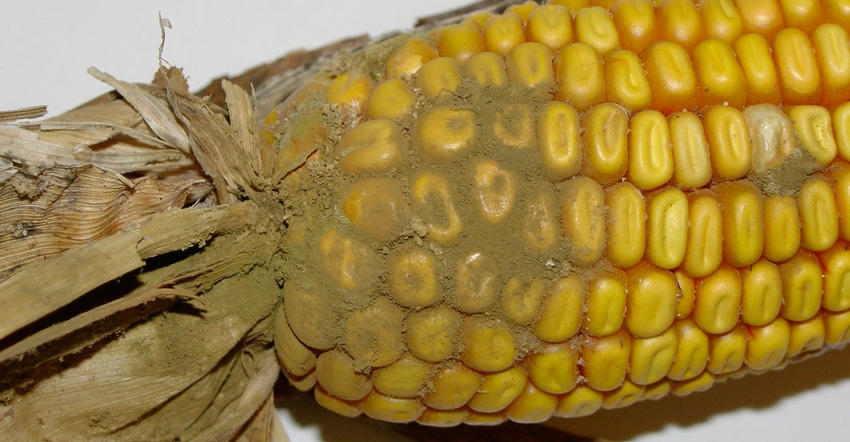September 29, 2017

Corn disease update
Diplodia ear rot plagued fields in 2016. This year, aspergillus and fusarium ear rots, which thrive in hot and dry conditions, are predominant.
Aspergillus ear rot is olive-colored, powdery mold growth on and between kernels. Surface mold can be found anywhere on the ear, but it’s typically found on the ear tip. Aspergillus spores overwinter in crop residue on the soil surface, and then become airborne and can infect the ear during pollination and grain fill. If aspergillus is confirmed, the corn must be tested to determine if aflatoxin is present and to decide the proper marketing channel. Aspergillus does not always produce aflatoxins, but it is more likely under heat and drought stress.
Fusarium ear rot pathogens overwinter on corn and other grass species residue, and then infect corn during pollination and grain fill. Farmers can identify fusarium ear rot by looking for white, pink or salmon in starburst patterns. Infected kernels may be tan or brown, and yield and grain quality may be impacted. While the Food and Drug Administration currently does not have limits on the amount of mycotoxins present in grain loads, it can be fatal to horses and pigs, and can severely damage organs of other mammals that digest these mycotoxins.
For more on common ear rots and molds, read this story.
Source: Burrus Seeds
U of I to host Animal Mortality Composting Workshop
The University of Illinois Extension will hold an Animal Mortality Composting Workshop on Nov. 3 from 9:30 a.m. to 3 p.m. near Perry.
“This workshop gives livestock producers the opportunity to visit a demonstration composting site and talk with a variety of experts on mortality composting,” says Neslihan Akdeniz, a clinical professor with the Department of Agricultural and Biological Engineering at U of I.
The workshop will begin at John Wood Community College Agricultural Education Center and will include several presentations on different aspects of carcass composting and new technologies. Ted Funk, professor emeritus in ABE, will discuss general requirements for successful on-farm mortality composting, including a range of options to ensure regulatory compliance. Akdeniz will explain how to manage for an efficient, nuisance-free mortality system. Matt Robert, Natural Resources Conservation Service engineer, will talk about facility designs that NRCS supports and system management requirements.
In the afternoon, the workshop will move to the U of I Orr Agricultural Research Center, where attendees will rotate through three demonstration stations, including moisture control, selecting and mixing a carbon source, measuring temperature in the compost, and site-specific design.
Attendees will have an opportunity to visit with vendors and exhibitors representing builders, composting equipment suppliers and service providers after the program.
Space is limited, and online registration closes on Oct. 26. There is a $25 fee for the first registrant and $10 for any additional people from the same farm. Registration includes lunch for each attendee and one heavy-duty thermometer per farm to use in composting. Spanish interpretation will be available on-site. For more information, call Akdeniz at 217-300-2644 or Stanley Solomon at 815-235-4125.
Source: University of Illinois
New ag curriculum for high schoolers
How are indoor barns impacting animal care? What is sustainable agriculture? How are new technologies improving water efficiency? High school students can learn the answers through U.S. Farmers and Ranchers Alliance’s Discovering Farmland curriculum featuring the award-winning documentary “Farmland.”
Companion activities for the curriculum include:
• new 360-degree videos about animal safety, health, comfort and environmental sustainability on a modern pig farm
• 12 different videos supporting PowerPoint-based lesson plans and activities on topics such as composting, sustainability and stereotypes
• food product label exploration by choosing products from virtual grocery store shelves featuring produce, meat and cereal, and a “Get to Know GMOs” activity
USFRA partnered with Discovery Education to promote the lesson plans to K-12 classrooms.
“This initiative has inspired students with an innovative curriculum that brings to life critical issues impacting the agriculture industry, such as sustainability, the new science and technology behind farming, and entrepreneurship,” says Randy Krotz, USFRA chief executive officer. “With the Discovering Farmland project reaching more than 1 million students, we want to continue that momentum and help inform the next generation of consumers.”
These resources are available to all high school students at discoveringfarmland.com and will become available through Discovery Education Streaming.
Source: USFRA
You May Also Like




